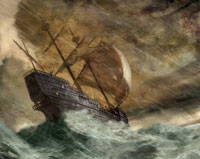
(Excerpts from "Plugging Into The Sun", Sept. National Geographic)
120 quadrillion watts of sunlight are constantly hitting the Earth, that is 6,000 times what we use and it eclipses (excuse the pun) the power generation potential of all other renewable energy sources like wind, hydro, tidal, and geothermal. For perspective, we generated 19,000 terawatt-hours of electricity in 2006. One terawatt-hour = 1,000 gigawatt-hours = 1 billion kilowatt-hours and one kilowatt-hour keeps a 100 watt light bulb glowing for 10 hours. 975,000 terawatt-hours could be generated using just the renewable energy worldwide, 51 times what actually we use.
Because of this government subsidies for solar power are very high, especially in Europe which leads the world in solar technology. This is especially true in Spain where, outside Seville Abendoa Solar's PS10 vast array of mirrors aim sunlight at a "power tower" to make steam for the generating plant's turbine.
Solar One near Las Vegas uses a similar approach for what engineers call solar thermal generation (versus photo-voltaic panels or PV for short). Long rows of curved mirrors called parabolic troughs focus the sun's heat on an oil-filled pipe that runs the length of each row. The hot oil is then run through a heat exchanger to again turn water into steam for the turbine.
Andasol 1 & 2, another Spanish solar installation on the plains of Andalusia use molten salt to store some of the heat generated during the daytime in order to continue boiling water for up to 7-1/2 hours after the sun goes down.
Germany is pioneering an economic incentive called a "feed-in tariff" to drive solar energy research. Anybody who installs a photo-voltaic system on their home can sell their surplus energy to the grid for a guaranteed above-market price for 20 years. That comes out to about an 8% return on investment.
At the Fraunhofer Institute for Solar Energy Systems outside Freiburg the next generation of PV research uses Fresnel lenses (like the ones used in lighthouses) to concentrate sunlight 500 times, raising the efficiency of a standard PV panel as high as 23%.
Solar panels are getting thinner and even bendable, allowing their use on more and more structural shapes. PV is less efficient than solar thermal though (the record panel so far converts sunlight at 40.8% capacity and it costs $10,000; average PV efficiency runs 10% to 20%), and storage has been a problem. Germany and Alabama however have been using compressed air for decades to store surplus daytime energy by pumping it into underground caverns and releasing it at night to spin the turbines.
PV has two big advantages over thermal solar energy; it can be placed at the point of use eliminating costly transmission facilities and it has no moving parts, just solar photons knocking electrons off of silicon atoms and generating a current. So if efficiency can be raised and effective storage designed PV might win out. One line of research is aiming for liquid PV if you can imagine . . . paint your house with it and switch on the power.
And MIT researcher Daniel Nocera has discovered a cheap, self-renewing catalyst which splits water into hydrogen and oxygen which are then stored in a fuel cell for nighttime use. According to Nocera the PV panels on your home's roof which power your home during the day generate enough surplus energy to drive this system with enough left over to sell on the grid. He claims your home can become a power plant on its own.







